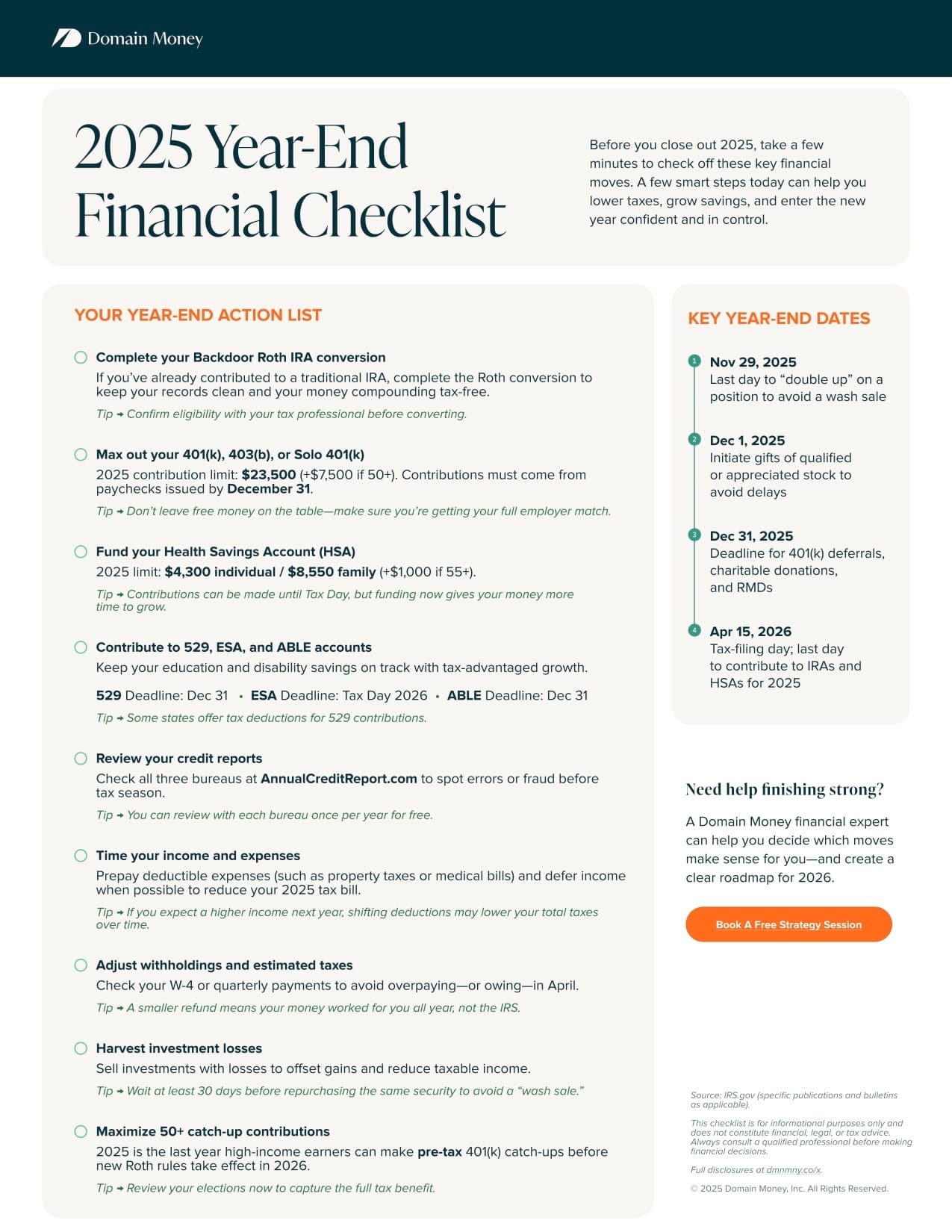Meet Alex, a senior software engineer at a major tech company. After landing a promotion that pushed his salary to $180,000, he discovered something frustrating: he suddenly made too much money to contribute to a Roth IRA. The IRS income limits had locked him out of one of the best retirement savings vehicles available.
"Wait," Alex thought, "I'm being penalized for earning more? That doesn't seem right."
He's not wrong to feel frustrated. The current Roth IRA income limits are $153,000 for single filers and $228,000 for married couples filing jointly. Cross those thresholds, and the IRS says you can't contribute directly to a Roth IRA—missing out on decades of tax-free growth.
But here's the thing: there's a perfectly legal workaround that high earners have been using for years. It's called the Backdoor Roth IRA, and if you're a high-earning professional, it might be one of the most valuable strategies in your retirement planning toolkit.
What exactly is a Backdoor Roth IRA?
The Backdoor Roth IRA isn't an official IRS term—it's a strategy that takes advantage of the fact that while there are income limits for Roth IRA contributions, there are no income limits for Roth IRA conversions.
Here's how it works: Instead of contributing directly to a Roth IRA (which you can't do due to income limits), you contribute to a traditional IRA (which has no income limits), then immediately convert those funds to a Roth IRA.
The process sounds more complicated than it actually is:
- Contribute to a traditional IRA ($7,000 for 2024, or $8,000 if you're 50 or older)
- Convert those funds to a Roth IRA
- Pay taxes on the conversion (which should be minimal if done immediately)
- Enjoy tax-free growth for the rest of your life
The beauty of this strategy is that it accomplishes exactly what a direct Roth contribution would do, just with an extra step.
Why the Backdoor Roth matters for your wealth
Let's put this in perspective with real numbers. That $7,000 annual contribution might not seem like much compared to your salary, but compound growth over time makes it incredibly valuable.
Assume you contribute $7,000 annually via the Backdoor Roth for 30 years, earning an average 7% return. Your total contributions: $210,000. Your account value at retirement: approximately $700,000. And here's the kicker—you'll never pay taxes on any of it again.
Compare that to a traditional 401(k), where every dollar you withdraw in retirement gets taxed as ordinary income. If you're in a 24% tax bracket in retirement, that $700,000 becomes $532,000 after taxes. The Backdoor Roth just saved you $168,000 in retirement taxes.
The step-by-step process
While the concept is straightforward, executing a Backdoor Roth correctly requires attention to detail. Here's the detailed process:
Step 1: Open accounts if needed You'll need both a traditional IRA and a Roth IRA. Most major brokerages can set these up quickly and often with no fees.
Step 2: Make your traditional IRA contribution Contribute up to $7,000 to your traditional IRA ($8,000 if you're 50+). Because you're a high earner, you won't be able to deduct this contribution, which actually makes the conversion cleaner from a tax perspective.
Step 3: Convert to Roth Contact your broker to convert the traditional IRA funds to your Roth IRA. This is usually a simple online process or phone call.
Step 4: Handle the paperwork You'll receive tax forms (5498 and 1099-R) documenting the contribution and conversion. Your tax preparer will use these to report the transaction properly.
Step 5: Repeat annually This isn't a one-time strategy. You can execute a Backdoor Roth every year as long as the current rules remain in place.
The pro-rata rule: The biggest potential complication
Here's where many people get tripped up: the pro-rata rule. If you have existing traditional IRA balances, the IRS requires you to consider all your traditional IRA money when calculating taxes on your conversion.
Let's say you have $28,000 sitting in a traditional IRA from an old 401(k) rollover, and you contribute $7,000 for your Backdoor Roth. When you convert that $7,000, the IRS doesn't let you convert just the new, non-deductible contribution. Instead, they look at your total traditional IRA balance ($35,000) and determine that 20% of your conversion ($7,000 ÷ $35,000) is from non-deductible contributions and 80% is from deductible contributions.
This means you'd owe taxes on $5,600 of your $7,000 conversion—probably not what you intended.
Strategies to handle existing traditional IRA balances
If you have existing traditional IRA money, you have several options:
Option 1: Roll into your 401(k) Many employer 401(k) plans accept incoming rollovers from traditional IRAs. By rolling your existing traditional IRA balance into your 401(k), you clear the way for clean Backdoor Roth conversions.
Option 2: Convert everything If the balance isn't too large, you might choose to convert your entire traditional IRA to Roth in one year, paying the taxes owed and clearing the decks for future Backdoor Roths.
Option 3: Accept the partial taxation Depending on your tax situation, you might decide the pro-rata taxation is still worth it for the long-term benefits.
Option 4: Use your spouse's situation If you're married and your spouse doesn't have traditional IRA balances, they can execute their own Backdoor Roth without pro-rata complications.
Timing considerations for maximum benefit
While you can execute a Backdoor Roth at any time during the year, timing can matter:
Early in the year: Making your contribution and conversion in January gives your money the maximum time to grow tax-free in the Roth environment.
End of year: December conversions can be useful for tax planning, especially if you want to manage your taxable income for the current year.
Market timing: If the market has declined after your contribution but before your conversion, you might actually benefit from converting at a lower value, then enjoying the recovery tax-free.
Integration with your broader retirement strategy
The Backdoor Roth shouldn't exist in isolation—it works best as part of a comprehensive retirement strategy. Here's how it typically fits:
After maximizing your 401(k): Most financial advisors recommend maxing out your 401(k) contribution (especially if you get an employer match) before implementing a Backdoor Roth.
Alongside other tax strategies: The Backdoor Roth creates tax diversification, giving you tax-free money to complement your tax-deferred 401(k) and taxable investments.
With estate planning: Roth IRAs have more favorable inheritance rules than traditional retirement accounts, making them valuable for legacy planning.
The Mega Backdoor Roth: Level up your strategy
If your employer's 401(k) plan allows it, you might also have access to the "Mega Backdoor Roth"—a strategy that can let you contribute up to an additional $48,500 to Roth accounts annually (as of 2024).
This advanced strategy involves making after-tax contributions to your 401(k) beyond the standard $23,000 limit, then converting those contributions to Roth. It's more complex and not available to everyone, but for those who can use it, the tax-free growth potential is enormous.
Real-world case study: Maximizing the strategy
Let's look at how one of our clients, Jennifer, used the Backdoor Roth as part of her comprehensive retirement strategy:
Background: Jennifer, a 35-year-old marketing director earning $160,000, was already maxing out her 401(k) and had built a six-month emergency fund.
Challenge: She wanted to save more for retirement but was locked out of direct Roth contributions due to her income.
Solution: We implemented a comprehensive strategy:
- Continued maxing out her 401(k) ($23,000 annually)
- Rolled an old traditional IRA into her current 401(k) to avoid pro-rata issues
- Began annual Backdoor Roth contributions ($7,000)
- Set up automatic investing within the Roth IRA for hands-off growth
Projection: By age 65, assuming 7% average returns, Jennifer's Backdoor Roth contributions alone are projected to grow to approximately $875,000—completely tax-free.
Combined with her 401(k) and other investments, Jennifer is on track for a comfortable retirement with tax diversification that will give her flexibility in managing her retirement tax burden.
Common mistakes to avoid
Even though the Backdoor Roth is relatively straightforward, there are several pitfalls to watch out for:
Contributing to both traditional and Roth: Don't accidentally make direct Roth contributions in the same year you're doing a Backdoor Roth. The combined contributions can't exceed the annual limit.
Forgetting about the timing: If you let contributed funds sit and grow in the traditional IRA before converting, you'll owe taxes on any gains.
Ignoring state taxes: Some states don't recognize Roth conversions the same way the federal government does, potentially creating state tax complications.
Missing the Form 8606: This form tracks your non-deductible IRA contributions. Missing it can cause problems down the road.
Not coordinating with other retirement moves: Rolling over 401(k)s or making other IRA moves in the same year can complicate your Backdoor Roth.
The political and legislative landscape
It's worth noting that the Backdoor Roth exists in something of a regulatory gray area. While it's completely legal under current law, there have been periodic discussions in Congress about closing this "loophole."
The strategy has survived multiple attempts at elimination, partly because it affects a relatively small number of taxpayers and the revenue impact isn't huge. However, tax laws can change, so it's worth implementing this strategy while it's available if it makes sense for your situation.
Is the Backdoor Roth right for you?
The Backdoor Roth makes the most sense if you:
Earn above the Roth IRA income limits: This is obviously the primary requirement—if you can contribute directly to a Roth, there's no need for the backdoor.
Have maximized other tax-advantaged accounts: It typically makes sense to max out your 401(k) (especially with employer matching) before implementing a Backdoor Roth.
Expect to be in a similar or higher tax bracket in retirement: The Roth's tax-free withdrawals are most valuable if you expect to pay similar or higher tax rates in the future.
Don't have large traditional IRA balances: The pro-rata rule can complicate the strategy if you have substantial traditional IRA assets.
Want tax diversification: Having both tax-deferred (401(k)) and tax-free (Roth) retirement money gives you flexibility in retirement.
Getting started: A practical action plan
If you think the Backdoor Roth might be right for you, here's how to get started:
- Assess your situation: Review your income, existing retirement accounts, and tax circumstances.
- Handle existing traditional IRA balances: Decide how to address any existing traditional IRA money to avoid pro-rata complications.
- Open necessary accounts: Set up traditional and Roth IRA accounts if you don't already have them.
- Execute your first conversion: Start with this year's contribution to get familiar with the process.
- Set up systems: Consider automating contributions and conversions to make this an annual habit.
- Plan for taxes: Work with your tax preparer to ensure proper reporting and understand the tax implications.
The power of starting early
Like most retirement strategies, the Backdoor Roth becomes more powerful the earlier you start. Consider two scenarios:
Early starter: Begins Backdoor Roth at age 30, contributes for 35 years
- Total contributions: $245,000
- Projected value at 65: ~$1.2 million (at 7% annual return)
Late starter: Begins Backdoor Roth at age 45, contributes for 20 years
- Total contributions: $140,000
- Projected value at 65: ~$300,000 (at 7% annual return)
The early starter ends up with four times as much money despite contributing only 75% more. That's the power of compound growth—and it's all tax-free.
Integration with professional guidance
While the mechanics of the Backdoor Roth are relatively simple, the strategy works best when integrated with comprehensive financial planning. A CERTIFIED FINANCIAL PLANNER® professional can help you:
- Determine if the strategy makes sense for your specific situation
- Coordinate the timing with other tax planning moves
- Handle complications like existing IRA balances
- Integrate the strategy with your broader retirement and estate planning goals
- Navigate any changes in tax law that might affect the strategy
Key Takeaways
The Backdoor Roth IRA represents one of the most valuable retirement planning strategies available to high-earning professionals. While the income limits on direct Roth contributions might seem like a barrier, the conversion option provides a clear pathway to tax-free retirement growth.
The strategy isn't complicated, but it does require attention to detail and proper execution. For most high earners who have already maximized their 401(k) contributions, the Backdoor Roth should be the next step in building a tax-efficient retirement strategy.
Remember, this isn't just about saving $7,000 per year—it's about creating hundreds of thousands of dollars in tax-free retirement income. In a world where tax rates are unpredictable and retirement costs continue to rise, having a pool of tax-free money provides invaluable flexibility and peace of mind.
Don't let income limits lock you out of Roth benefits. The backdoor is open, legal, and waiting for you to walk through it.
Ready to unlock tax-free retirement growth?
At Domain Money, our team of expert CFP® professionals specializes in helping high-earning individuals navigate sophisticated retirement strategies like the Backdoor Roth IRA. We'll analyze your current situation, handle any complications with existing retirement accounts, and integrate the strategy seamlessly with your broader financial plan.
Don't miss out on decades of tax-free growth. Schedule a free strategy session today to learn how the Backdoor Roth IRA can enhance your retirement planning and build lasting wealth.
The scenarios described in this article are for illustrative purposes only and do not represent actual client situations. Individual results may vary based on personal circumstances, market conditions, and tax laws. Retirement planning strategies should be implemented in consultation with qualified financial and tax professionals. Past performance does not guarantee future results. Tax laws are subject to change.









.webp)
.jpeg)